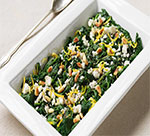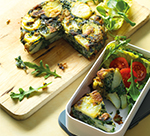
Spinach is one of our first spring crops. It’s a good source of dietary fibre and contains a wide range of vitamins, minerals and phytonutrients including lutein, which is associated with good eye health.
However, contrary to popular belief spinach isn’t a brilliant source of iron. This myth was spread when in 1870 a German scientist accidentally moved a decimal point, giving spinach 10 times more iron than it actually contains.
FIfty years later, the cartoon character Popeye was used by the canned spinach industry to exploit the myth. It wasn’t until the mid-1930s that the mistake was spotted but many people still believe it today.
How to buy
Spinach is available year round – or buy from frozen. However it's at it's best when it's fresh between March and June. When buying, look for bright green leaves, a fresh smell and no yellow or wilting leaves. It reduces to around a quarter of its size when cooked.
How to store
Keep in the fridge in a perforated bag for up to four days.
How to prepare
If using bagged, pre-washed spinach give it a quick rinse. If using fresh spinach, wash thoroughly to remove any residue soil or chemicals. Shake off the water and drain. Cut off any thick stems.
How to cook
Don’t boil spinach – steam, stir-fry or microwave to preserve the nutrients.
Here are a few of spinach recipes for you to try. You can find more in our recipe finder.

A light spinach salad with a zesty dressing, the perfect accompaniment to a summer barbecue.

Spinach, red onion and potato tortilla. This is perfect warm or cold – perfect for lunch on the go, a picnic or barbecue.

Spinach and mushroom lasagne. A lower-fat lasagne made with creamy spinach and mushroom sauce topped with cheesy fresh tomatoes.
